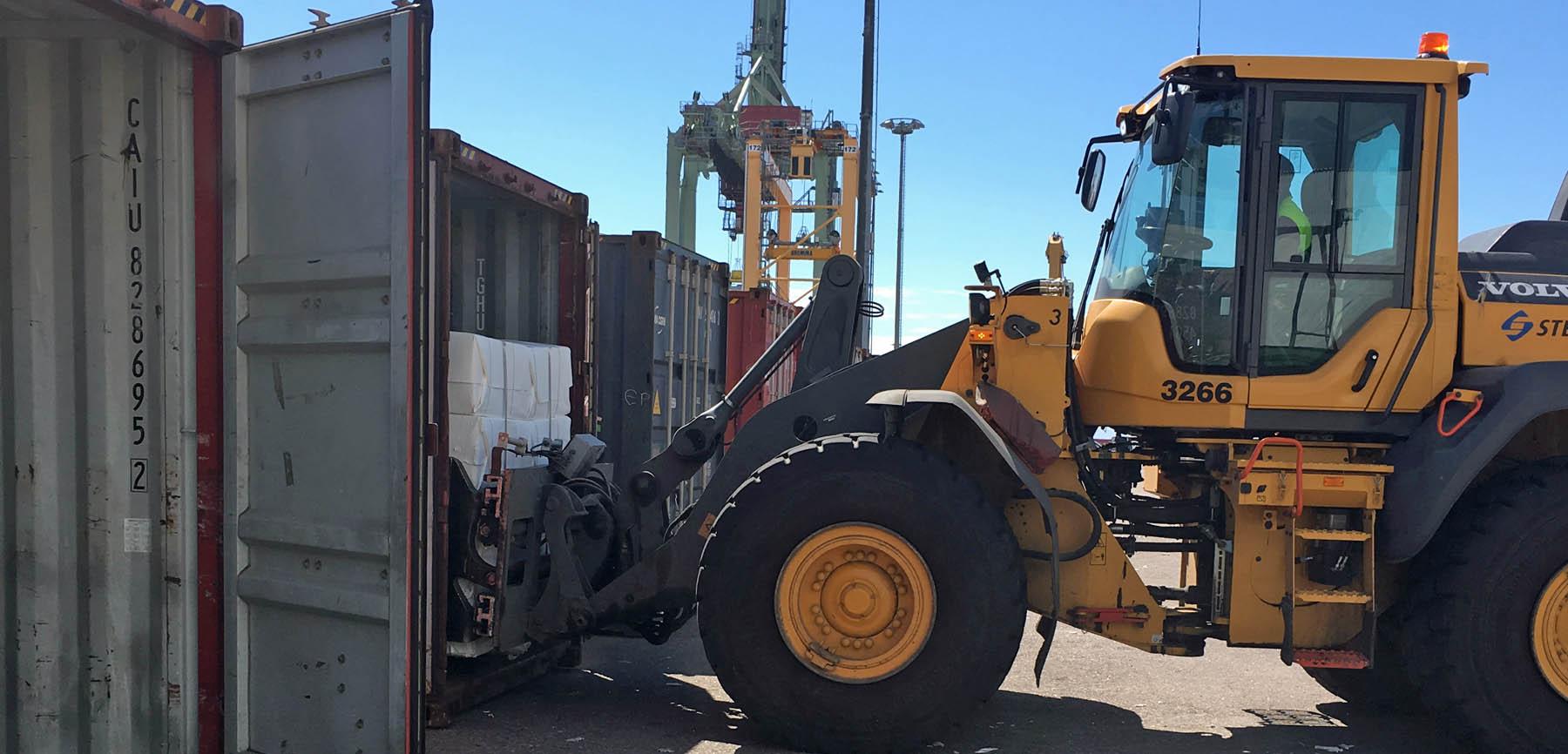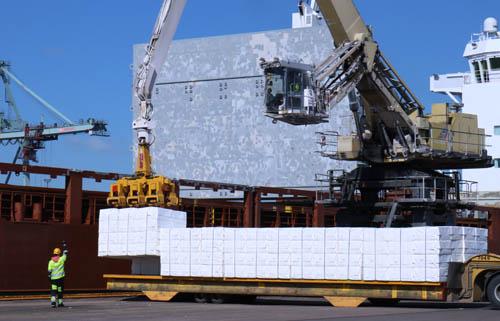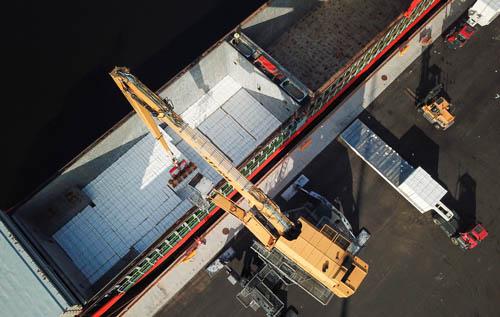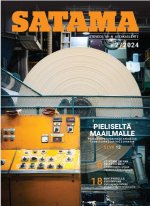A wide range of pulp logistics options

The centralisation of pulp transport at Steveco's Mussalo terminal will increase pulp logistics efficiency and flexibility.
The pulp market has undergone quite a change over the last twenty years. Where pulp was previously produced mainly for domestic paper and board mills, the major part is now exported as market pulp. This has increased the volume of container traffic.
“The needs of our customer companies have changed as the market has expanded. Exports to China in particular have grown rapidly. Containers as a transport mode have a primary role because all logistics there relies on containers,” says Markus Myllylä, Steveco's Sales Director.
"The use of containers does not require moving tens of thousands of tonnes; instead, the pulp can be delivered even in smaller batches on a continuous and regular basis."
Rising global freight rates and problems with the availability of containers mean that other options must be available alongside container traffic. Break bulk, which has always figured strongly in South American pulp exports, has become an important part of maritime pulp logistics in Finland as well.
Container shortage means an uptick in break bulk demand
Container transport of pulp became expensive as container transport developed problems with availability, capacity and pricing. Pulp exporters began to consider break bulk vessels as alternatives, which can be loaded with anything from 10,000 tonnes to 60,000 tonnes of pulp. Steveco was involved in that development.
“We set out to develop a pulp logistics area in Mussalo where full-length trains can enter without breaking the train. Another thing is a warehouse customised for pulp, which is very different from a regular paper warehouse. The underlying planning principle was that we can offer all forms of pulp logistics to our customers in one area,” says Tapio Mattila, Senior Vice President, Sales.
The uniqueness of the pulp terminal lies in its versatility. It offers the customer a full range of logistics options at very short notice. If necessary, the pulp can be loaded in bulk on a large or small ship or transported in a container. The pulp can also be loaded onto trucks or rail wagons, either in containers or in bulk.
“At the Mussalo pulp terminal, it is possible to choose any form of transport to anywhere in the world from one location, even at short notice. Decisions can therefore be made very quickly,” says Myllylä.
In the past, there were rather few options for break bulk to China, for example, and larger ships had to call at several ports. Now a choice of 10,000–60,000-tonne ships from several shipping companies is available. If necessary, they can get a full cargo at once, so that the freight price per tonne of pulp stays reasonable.
“The use of even smaller ships has increased significantly due to container problems. Every call to a port increases the price of freight, so loading at one stop is a cost-effective way to operate,” says Myllylä.
Services developed together with forest companies

Steveco has been developing pulp export logistics for decades with several forestry companies. The Mussalo pulp terminal in Kotka is the most prominent achievement of this development work to date.
“Our terminal is one of Finland's first world-class pulp terminals. It allows us to supply the world with products from several different companies in the same environment. Logistics integration can bring significant benefits,” Myllylä emphasises.
The site, specifically tailored for pulp logistics, was opened in autumn 2019. It includes a 20,000-square metre warehouse, a 20-hectare field, and a new 220-metre pier. They were constructed as a joint venture by Steveco, the Port of HaminaKotka and UPM. The project was boosted by UPM's decision to concentrate all maritime traffic from the Kaukas and Kymi pulp mills in Kotka.
On the other side of the quay in the same area, pulp from Metsä Group's mills is handled.
A new phase in the terminal area will begin now that Steveco will build a new 24,000-square metre terminal, primarily for Stora Enso, scheduled for completion in autumn 2022.
"The terminal is in a great location in the Mussalo D area and offers efficient, safe and environmentally-friendly delivery options for various modes of transport both to Europe and overseas," says Timo Hatva, Stora Enso's Senior Vice President, Logistics in Finland.
The extensive concentration of pulp logistics operations serves the forest industry and the entire Finnish economy.
"The D area of Mussalo has become a nationally significant logistics centre for the forest industry, and with its 15.3-metre fairway depth, it is competitive in the entire Baltic Sea region," says Kimmo Naski, CEO of HaminaKotka port.
Smooth operations across the transportation chain
The handling of containers is already a smooth operation right at the beginning of the logistics chain because the pulp enters the port in units dimensioned according to the size and load capacity of the containers.
Container loading is centralised at the port since it is not very practical to transport containers to pulp mills. A regular flow of empty containers returns to the port.
"The pulp comes in full trains to Mussalo, where wagons are unloaded and containers filled very fast," says Myllylä.
Pulp exports through Steveco have grown by more than 50 per cent in the last five years. Last year, Steveco already processed almost two million tonnes of export pulp, which is about 50 per cent of Finland’s pulp exports. Containers were used for 60 per cent of the total amount, while 40 per cent was transported in bulk.
The Mussalo terminal utilises the latest technology in pulp transport. Many pulp units come with a RFID tag that allows the manufacturer to see where in their mill system each unit is moving and how each product unit is handled.
Listening to customers results in new services
Steveco will continue to be the largest and most reliable high-quality pulp handler in Finland. This has been achieved through the continuous development of services together with its customers.
"We are further developing a multifunctional pulp terminal that serves our customers in all market situations so that they can decide, even at the last minute, which mode of transport to use to move the goods," says Myllylä.
Customers have clear goals for ongoing development of pulp terminal services.
“Operations must be completely uninterrupted and predictable. There can be no surprises. In the event of deviations, there must be room for making capacity adjustments. We are constantly developing cost-efficiency. Operations must be completely transparent and paperless,” says Mattila, summing up Steveco's development goals.
UPM trusts Steveco

The growing uncertainty in the container market has had a significant impact on the forest giant UPM's logistics. When the demand for containers rose sharply, Matti Tamminen, Logistics Director of UPM's pulp business, had to start thinking about logistics solutions in a new way. Since 2018, he has led the global logistics of the company’s pulp business in Mannheim, Germany.
All pulp from UPM's Kymi and Kaukas mills to the Asian market normally travels in containers and to Europe in bulk. The containers to Asia are shipped from the port of Mussalo in Kotka by feeder vessels to the ports of Central Europe, from where they are reloaded on ocean-going vessels. Europe accounts for about two-thirds and Asia for about one-third of the pulp leaving Kotka.
The majority of pulp container capacity is secured by transportation contracts. However, bottlenecks in the global container market last year caused occasional disruptions to capacity availability.
“During the last summer and autumn, we decided to move some of the pulp transports from Finland to the Far East to bulk carriers. They accounted for about one-fifth of Asian volume last year. At the moment, it looks as though we can cope with containers,” he says.
The pulp terminal built by Steveco and UPM in Area D of the Port of Mussalo is a major hub for UPM's pulp logistics.
“At the end of 2019, we concentrated the shipments of Kymi and Kaukas production in Mussalo. Centralisation gives our transport planning more flexibility. Handling at our warehouses is now much more modern. We can transport even more of our pulp by rail directly to the port. Steveco is an extremely important partner for us as we continuously develop this logistics chain,” says Tamminen.
The area will continue to develop as new piers are completed and another pulp storage facility is built in Area D.
“In the future, we will be able to switch even more of our logistics from road to rail. Train scheduling and operational efficiency will improve in the future when two unloading tracks can be used. Finland's largest container terminal, right next to our warehouse, gives us the flexibility to send our containers all across the world's seas,” says Tamminen.
Steveco and UPM are developing the digitalisation of pulp logistics to provide better transparency throughout the logistics chain. Minimising the carbon footprint is another important area for development. The continual increase in rail transport has been a great success.
Text: Jukka Nortio
Photos: Steveco Oy
The article was first published in Steveco's customer magazine in May 2022
About Author

Satama
SATAMA is our customer magazine. it is published twice a year in Finnish.
